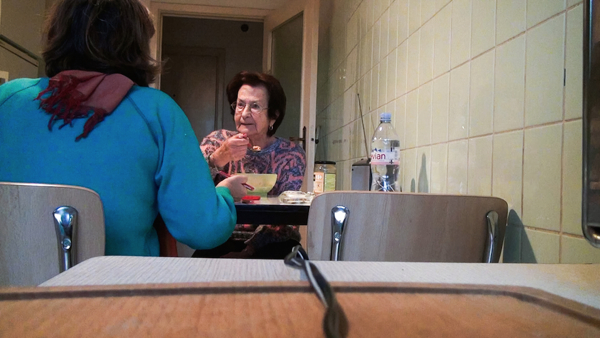Movie review by Greg Carlson
Following its Locarno Film Festival premiere in August of 2015, the great Chantal Akerman’s final work, “No Home Movie,” now makes its way to limited theatrical release and digital platforms in the United States. Currently viewable on Fandor – a fitting small screen residence – the nonfiction meditation featuring Akerman’s mother Natalia in her twilight takes on new shades of meaning and acute pangs of melancholy in light of Akerman’s October 2015 suicide. Natalia died in 2014. A study of contrasts, the movie is alternately inviting and chilly, intimate and detached, demanding and comfortable.
Natalia, a Pole who survived Auschwitz but lost her parents there, shares several conversations with Chantal throughout the course of the movie, often over a meal and seated at a kitchen table. The two speak candidly and urgently – in the way that any parent and grown-up child might – about all kinds of things. From the philosophical to the quotidian, Chantal engages Natalia on dietary habits, the challenges of the elderly, childhood memories, motherly advice, family history, and politics and religion. The little squabbles and teasing give-and-take are suggestive of a big love. As the film goes on, Akerman’s travels take her away from Brussels, and she and Natalia meet over Skype.
Several critics commenting on “No Home Movie” have tackled the metaphoric possibilities of the movie’s introductory image of a windblown tree whipped in a desert landscape (reportedly shot in Israel but not geographically identified in the film). In a typical reading, Clayton Dillard equates the tenacious roots and branches to Natalia, claiming that “Akerman turns an initial instance of isolation into a visual leitmotif, where subsequent iterations of singular personages, whether a man on a bench or a lawn chair in the backyard, serve as functional equivalents for Natalia’s disintegrating self.” As Akerman takes us deeper into the film, evidence of Natalia’s failing health moves into the foreground.
Akerman’s decision to collect the images for “No Home Movie” on digital video provides the work with a particular quality that implies a homemade or handcrafted character. In many scenes, the viewer is left with the impression that the camera has been placed on a tabletop or perched on a counter (perhaps to blend in unobtrusively and become invisible to the subject being filmed), and the apparent absence of a tripod suggests additional DIY sensibilities. The compositions, often framing spaces through open doorways and capturing speakers from behind, work in tandem with the auditory effect of hearing dialogue without being able to always see the face of the person talking.
As the swan song of a legendary filmmaker, “No Home Movie” might direct newcomers to Akerman’s best-known film, “Jeanne Dielman, 23 quai du Commerce, 1080 Bruxelles,” alluded to in both a potato-peeling anecdote and, as Peter Debruge points out, the “domestic apathy” embodied by Natalia. “No Home Movie” also calls to mind the excellent “News from Home,” among other films in Akerman’s oeuvre. That Akerman herself appears – the last time we see her, in a staged callback to a story about shoelaces – is a haunting sight. Viewers experiencing “No Home Movie” will now negotiate its meanings and messages in terms of two deaths instead of one.
